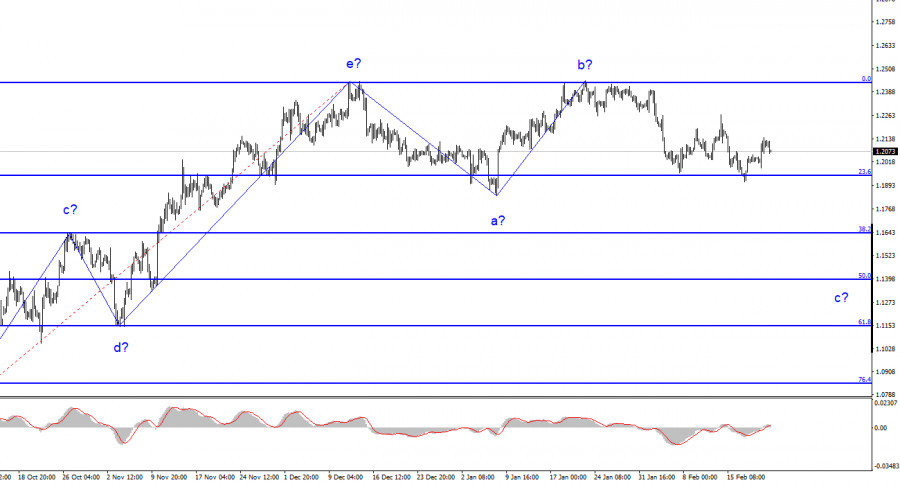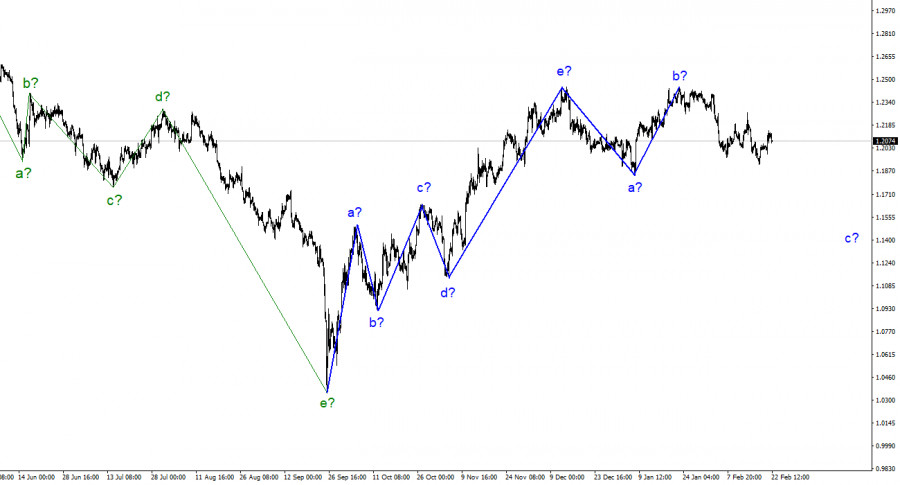

The wave analysis for the pound/dollar pair now appears to be challenging, but it does not call for any clarifications. The wave patterns for the euro and the pound differ somewhat, but both point to a decrease. Our five-wave upward trend segment has the pattern a-b-c-d-e and is most likely already finished. I predict that the downward section of the trend has begun and will continue to develop, taking at least a three-wave form. Although Wave B appeared to be unnecessarily prolonged, it did not cancel. Hence, it is assumed that a wave has now started to form with a downward trend section, the targets of which are situated below wave a's low. In other words, at least 100–200 points less than the current rate. Although it's too soon to speculate, I believe wave c may end up being deeper and that the entire downward section of the trend may potentially adopt a five-wave pattern. It took a long time for the pair to start moving quotes away from the peaks reached, although it had been on the verge of restarting the development of an upward trend segment. Since wave c has not yet finished, the low of the assumed wave a has not yet been broken.
Despite good indicators, the pound is still in danger.
On Wednesday, the pound/dollar exchange rate decreased by 20 basis points, beginning to recover yesterday's growth. Let me remind you that yesterday the UK announced strong business activity indices. Powerful in the sense that they exceeded both past values and market expectations. After a day, though, I wish to point out to readers that any index value below 50.0 is regarded as bad. The manufacturing sector's index increased from 47.0 to 49.2 points, although this rise does not signal a change from negative dynamics to positive ones. Hence, I conclude that the pound will not be able to use yesterday's reports for a very long time.
Let me also remind you that leading indicators are business activity indices. We can anticipate economic growth if they increase. And these improvements are now desperately needed for the British economy and the pound. The Bank of England won't be able to keep raising interest rates to combat high inflation if the economy contracts (no one called the recession off). Sooner or later, inflation will stop decreasing, and the pound won't have market support since the rate of growth will either be too sluggish or nonexistent. Now that it has reached 4%, which is high, the regulator is forced to consider another slowdown. A strong economy is crucial for the pound, but because it hasn't yet gone past Brexit, there could be major issues. Prime Minister Rishi Sunak has already publicly acknowledged that the decision to leave the European Union was a mistake and that steps will be taken by his administration to restore relations with the EU. If things run smoothly without the EU, nobody would try to reestablish ties with the organization.

The development of a downward trend section is implied by the wave pattern of the pound/dollar pair. Currently, sales with targets at the level of 1.1508, or 50.0% Fibonacci, might be taken into account. The peaks of waves e and b could be used to place a Stop Loss order. Wave c might be shorter, but for the time being, I anticipate a further 300-point drop (from current levels).
The image resembles that of the euro/dollar pair at higher wave scales, but there are still minor distinctions. The upward correction section of the trend has now been completed. If this presumption is true, then we must wait for the development of a downward section to continue for at least three waves with the possibility of a decrease in the region of Figure 15.